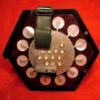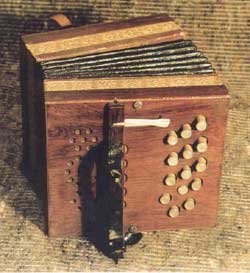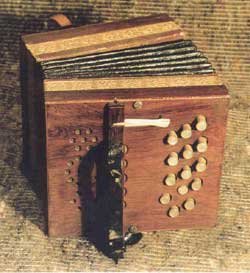-
Posts
5,167 -
Joined
Everything posted by Stephen Chambers
-
Yes exactly like that The nut has a deep groove in each side. The Nuts are very much broader that usual and the securing screws are brass, all the other concertinas I've been inside have steel screws. Then my first conclusion, based on the label, was correct. The combination of those two features is only found in concertinas made by the Nickolds family, the brass securing screws are typical too. I have a late, English system, example beside me, with the label "LATEST IMPROVED CONCERTINA, NICKOLDS AND CO., Manufacturers, LONDON", also rubber-stamped internally "F. C. NICKOLDS, Concertina Manufacturer, 161, Clarendon Road, Notting Hill" (one of many addresses), which has similar batch numbers (R16 and L16) pencilled inside the ends and no serial number, like yours, but some of their concertinas do have serial numbers, which go into the 8000's. Unfortunately the vast majority of their instruments do not have labels, or any other markings, to identify them, or they bear only the labels of the dealers they were made for. They were the toolmakers and metal workers at Wheatstone's, until they were displaced by the superior tooling and the machinery of Louis Lachenal in 1848. They set up as makers themselves in that year. Frederick Charles Nickolds (one of the sons) seems to have carried on making into the 1890's.
-
Theo, I have seen concertinas with that label which were made by the Nickolds family, though the fretwork on this one does look very fine for one of theirs. The pencilled number sounds more like a batch number (for manufacturing purposes) than a serial number. Are the pillars, on which the levers pivot, similar to Lachenal but open on one side ? (More like a "C" than an "O".) You should find that the reed is held in place, on its shoe, by a brass "nut" (clamping plate) with two screws passing through it. Is this "nut" drilled to receive these two screws, or does it have a groove in each side for them ?
-
Exactly so ! The traditional name for the "hand-bars", at Wheatstone's, was indeed "rails". I would suspect that "duet straps" probably infers that these were what Steve Dickinson (at Wheatstone's) still refers to as "new-style" straps, which have a cutaway to accomodate the hand, and both ends fasten onto the rails, as opposed to "old-style" (traditional anglo) ones which are straight and held by a topscrew, on the side of the instrument.
-
I know just what you mean Chris, its addictive, I'm acquiring a serious eBay "habit", I already seem to need two or three "fixes" a week. Where will it all end ? Maybe I will soon be having to "score" a 120-bass every day ! (And then where will I be ?) On a more serious note, I have come across similar D.I.Y. handstraps on English concertinas before. Some people may have done it as an "improvement", to make the instrument easier to hold (though most of us would find the opposite, and that their hands were very cramped by it), but I think it was more often done because someone was defeated by the prospect of making new thumbstraps. Mind you, I was looking through the Wheatstone ledgers (from the 1930's) last night, and came across a curious reference to what appears to have been an English concertina with rails and handstraps, but I was looking for something else and didn't make a note of the number. (Mea culpa !) Sounds like me !
-
Kerry, That certainly looks like an 1850's Wheatstone English system concertina that (with brass reeds) would have sold for 8 guineas ! As I said, it was originally sold to a Mr. Boyett (at least that is what it looks like !), on 7th September, 1853. It was a relatively expensive model at the time, with its gold-tooled bellows, fancy papers (this is sometimes described as the "Patent-bellows model", because one of the bellows papers is usually printed "C. Wheatstone & Co., Inventors & Patentees"), inlaid corners and silver buttons. The original label of your concertina would have had Wheatstone's old address, 20, Conduit Street, Regent Street, but the instrument has evidently been back to the firm in later years (for tuning, repairs etc.) and had its label replaced in the process.
-
It might not be an anglo, but it does wonderfully illustrate the German development of Uhlig's basic design, the anglo-German (which evolved into the anglo-chromatic) being the English development. Thanks for a great link Andrew !
-
Why is everbody assuming that it has to be a Lachenal duet of some kind ? The owner has already stated that it is a Wheatstone. The Salvation Army have used a lot more English-system concertinas than Triumph (Crane) duets, though the last Salvationist concertina player I saw had a Maccann duet (marching down my street, in Leyton, East London, about 20 years ago). Mind you, historically they seem to have used more anglos than all the other systems put together ! Kerry, do we have you thoroughly confused by now ? Edited to add more info.
-
I replied directly to the question at the top of the page (which seems to have gone unnoticed ?), which is the title of the Topic : "Can Any One Help With Some Info, Wheatstone concertina 48 key s/n 5290" Assuming that it is indeed by Wheatstone, as Kerry states, and given that serial number, then it has to be an English system, though nobody stated that. Edited to remove errant smilie in Quote.
-

What Other Hobbies Do You Have
Stephen Chambers replied to Sharron's topic in General Concertina Discussion
Well I used to have a "hobby", in the form of a music shop, but I gave that up on Saturday. So now I can get on with my "work", or is that my "hobby", which is which ? -
Kerry, This information is not generally available yet, though Bob Gaskins is working on digitizing those ledgers, for the Horniman Museum. However, I have a set of photocopies, so I can tell you that Wheatstone s/n 5290 was sold to a Mr. Boyett (?) on 7th September 1853, for £8. 8s. 0d (8 guineas).
-

Concertina Pictures
Stephen Chambers replied to Lester Bailey's topic in General Concertina Discussion
That's interesting ! Richard Carlin, who interviewed the sisters in the early '70's, was told that their black instruments were considered too drab-looking by a promoter, so it looks like a quick (& cheap) "gilding" job was done, using gold paint, so as not to lose the work. I think it had been assumed that these "gold-plated" aeolas had been made specially for them. I can understand why you have had it removed (I did the same with the bellows of the "pearly king" duet that I had - I've still got the "pearly" handstraps though), but, in a way, it is a pity to change such an historic set of instruments. Yes, the word is indeed "bright", implying that the ends were brightly finished (for stage use ?) when it was made, S.A. is for single-action (it plays only on the press ?), 9 1/8" is the size of the ends. -
Yes, that is my photograph, and the instrument is one in my collection of historical concertinas. The image has been reproduced by both Harry Geuns', and also by Daniel Melander's "Concertina Cafe" website. The basic design is simple enough, it is of 100% standard German construction, the biggest problem would be to reproduce the external appearance. You would need to be able to veneer rosewood, and it would probably be a big problem to find a similar gold-embossed paper for the bellows frames, you would also need to carve a similar windkey. Perhaps a later, small, German instrument could be adapted to look like it ? Probably because the style became obsolete 140 years ago ? I'm sure that there were more of them (I think this one is numbered 42), but have any other examples survived ? How about "Keep squeezing !" (It should do for both pipers and concertina players.)
-

Concertina Pictures
Stephen Chambers replied to Lester Bailey's topic in General Concertina Discussion
............... Well mine was made in Church Point, Louisiana. (Thanks John !) (Does that make it OK ?) Edited to add Smilies. -

Concertina Pictures
Stephen Chambers replied to Lester Bailey's topic in General Concertina Discussion
I was just going to make you an offer ! -

Concertina Pictures
Stephen Chambers replied to Lester Bailey's topic in General Concertina Discussion
Aren't they gold plated on the metal, and gold leafed on the the wood & leather ? It seems that the "ebony" finish was considered too drab for the Fayre Four to use on stage, Alf Edwards had a similar "gold" finished instrument, also for stage use. Mind you, I did once have a "Pearly King's" aeola Maccann duet, which did have bellows that were painted gold, pearl buttons stitched onto the handstraps too ! -
Andrew, That is one of my concertinas, I presume you found the picture on Harry Geuns' website (?) I'm glad you like it, but I have bad news for you, in that I'm afraid that I have no intention of selling it. I also have bad news for Paul, as the reeds, like all the other early German concertinas that I have, are made of German silver (neusilber), not steel. I bought this instrument from my old friend, the antique dealer & banjo collector, Reuben Reubens, about 20 years ago, at an Antiques Fair in Luton, Bedfordshire (England), where he had just bought it off one of the stalls. It even still has its original buckled, patent leather, straps, but the most striking feature is the windkey, which is a piece of ivory carved to resemble a forearm, complete with hand. The attribution to Uhlig is not mine, there is no maker's name on it, though it may well be from Chemnitz. Joachim, I would be very interested to see your Uhlig, when we meet in Frankfurt !Please let me know more about it. Cheers,
-

The Concertina In U.s. Folk Music
Stephen Chambers replied to Farmer John's topic in Concertina History
I don't have any specific information on the concertina in rural U.S. folk music, but I can give you an idea of the historical "general trend" in manufacture/playing of concertinas v. accordions. Following the invention of the accordion (Vienna, 1829), makers in Paris quickly brought out their own version, the "French accordeon" (now often referred to, by the name of one of its variants, as the "flutina"), which dominated the market for free reed instruments into the 1850's. In the early 1850's the production of the "German concertina" was taken up in rural Klingenthal (where labour was cheaper), in Saxony, and the inexpensive concertinas that they produced took over from the "French accordeon" in popularity. Following the Franco-Prussian War, and the resulting unification of the country, German manufacturing and trade were actively encouraged in the 1870's, and the cheap "German accordion" (also known as the "melodeon"), with stops to change the tone and keys to provide a simple accompaniment, became the most popular. This instrument is the type still used in Cajun music (where it is sometimes called, confusingly, the "French accordion"), and is the type of diatonic accordion you have most likely seen in museums. The "piano accordion" is a later development, virtually unheard of until the early years of the 20th century, gaining a lot of popularity in the 1920's, and reaching its peak in the '30's. So if you are looking for evidence of concertina playing in the "Old South", I would suggest you try the period 10 years before & after the Civil War (say 1850-1875) as the most likely. -

Concertina Made By H. Dean
Stephen Chambers replied to Ole Munch-Pedersen's topic in Concertina History
Pete, Having been in pretty much the same line of business as H. Dean, I could imagine several circumstances where he might have changed the case (assuming that it was he who did it). The case might have been badly damaged, or not suitable for the instrument when he got it, though, of course, it could be simply be that the purchaser asked for a nicer case with the instrument, and Mr. Dean had a rosewood one to spare. It is very easy for a dealer to end up with a selection of cases that are looking for a new home (or should that be "looking to provide a new home" ?). Apart from "wrong" cases with instruments, you sometimes find that they were such a tight fit originally that they no longer take the instrument if you simply change the straps, never mind if you have to repair, or even replace the bellows. Then again, you are sometimes left with an old, hexagonal, case simply because the buyer wants a new square one instead. As you mention, the old deal cases were "a bit tacky", but they did help to make it possible for Lachenal's to offer a significant reduction in the cost of the instrument when it was new. An 1862 Lachenal price list reveals the following inexpensive models/prices (Ole's instrument being No. 1.) : 1. THE PEOPLE'S CONCERTINA. Mahogany, in neatly covered box. ... £2 2s 2. Rosewood. Superior tone and finish. ... ... ... ... Mahogany Box. ... £3 3s 3. Ditto, best finish, Five-fold Bellows, best } ... ... Mahogany Box. ... £4 4s finished 4. Ditto, best finish, Five-fold Morocco Bellows, }.. Rosewood Box. ... £5 5s Moulded Edges While the most expensive model listed ( No. 9., with ivory ends, and the options of gold reeds and double pans) would have cost an astronomical 20 guineas, ten times the price of the one in the deal box. -
Since writing the above, I have received an email from Geoff Crabb, in which he mentions that he too has seen these fancy metal handles on an instrument. Geoff goes on to say that "... they appeared in an old ironmongers catalogue as drawer pulls (handles). We had a copy in the shop ...", so I was correct in describing them as having that appearance. This has jogged my memory, because I now think that I also saw them on a 38-key by Henry Crabb (Geoff's grandfather), that Paul Davies had years ago.
-

Congratulations To Jim
Stephen Chambers replied to Chris Timson's topic in General Concertina Discussion
They were very genteel, Victorian mandolists, they wouldn't have dared be improper ! Why do you think I wear earplugs ? -
Robin, The answer to your question is yes, but nothing came of it. Lachenal & Co. experimented with this idea, maybe around 1930, as a 2-row chromatic (probably C/C#) melodeon has survived. It was numbered C1223 in the former Concertina Museum Collection, and is presumably now at the Horniman Museum. There have also been accordion-tuned, English-made, concertinas and even a Wheatstone Bandonion, but that is another story ...
-

Congratulations To Jim
Stephen Chambers replied to Chris Timson's topic in General Concertina Discussion
It may not be commonplace, but "mandolist" is proper, I have come across it used to describe a mandola player.



